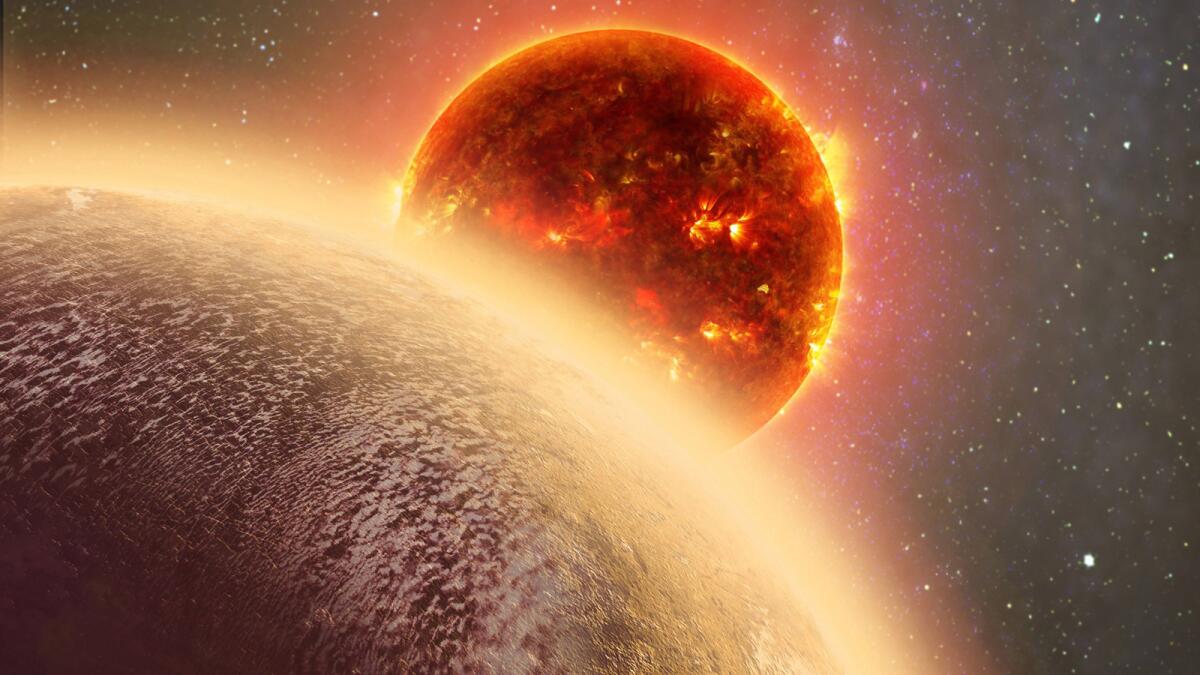Scientists think they just found the most important planet outside our solar system

This artist’s conception made by Dana Berry of SkyWorks and provided by NASA on Nov. 6 shows GJ 1132b, front, a rocky planet similar to the Earth in size and mass, orbiting a red dwarf star.
- Share via
A small planet, just a bit bigger than Earth, has been spotted in our stellar neighborhood, just 39 light-years away.
Known as GJ 1132b, it is the closest rocky exoplanet to have ever been found, and astronomers say it could provide our most in-depth look yet at an alien world not so different than our own.
Drake Deming, an astronomer at the University of Maryland, was so excited about the findings, published this week in Nature, that he described the new world as “arguably the most important planet ever found outside the solar system” in an accompanying News and Views article.
The newly discovered planet is just 16% larger than Earth, and it is made of rock and metal like our own planet. However, scientists say it is not likely to host life as we know it.
Its small, dim, sun is just one-fifth the size of our own sun, but GJ 1132b circles it at a distance of just 1.4 million miles, completing a full orbit once every 1.6 Earth days. (For perspective, Mercury orbits the sun from a distance of 36 million miles.)
The exoplanet’s close proximity to its host star keeps its temperature at a broiling 500 degrees Fahrenheit -- or about as hot as the highest setting on your home oven, said Zachory Berta-Thompson, a post-doc in MIT’s Kavli Institute for Astrophysics and Space Research.
At that temperature, liquid water cannot exist on the planet’s surface, although scientists say it is likely the planet still has an atmosphere.
“Our best guess is that this planet looks like Venus,” said Berta-Thompson, who was also the first author on the study. “But we won’t have to guess for long. This is the first rocky planet for which we have the chance to go out and observe its atmosphere.”
GJ 1132b was discovered with the help of the MEarth-South Observatory, a Harvard University lead array of eight 16-inch wide robotic telescopes stationed in the mountains of Chile. The array is specifically tasked with looking among nearby stars for exoplanets that in some way resemble Earth.
“The idea is if we can find the planet in a small telescope, we can study it in much more detail with a large telescope,” said Berta-Thompson.
The researchers first detected GJ 1132b in May 2014, when they noticed a telltale dip in the brightness of a small red dwarf star that suggested a planet had passed in front of it, blocking some of its light.
After confirming the finding with a smattering of other telescopes, the researchers proceeded to do a series of measurements and calculations to characterize the exoplanet.
By measuring how much the star dims each time the planet passes in front of it they were able to determine the planet is just a bit bigger than Earth.
By looking at the frequency of the dips in the star’s brightness they could say with certainty that the planet orbits its sun once every 1.6 Earth days.
The orbital period of the planet can also be used to calculate how far the exoplanet is from its host star, which in turn helped the researchers estimate how much the planet is likely heated by its star.
And there’s more.
Planets exert a slight gravitational pull on their host stars, causing them to wobble. By measuring how much a star wobbles, astronomers can determine an exoplanet’s mass. Because they also know its size from looking at how much light it blocks, they can also figure out the planet’s density.
“The density was telling us that this planet is for the most part a big ball of rock and iron, and not just big puffy ball,” Berta-Thompson said. “For example, we could have measured that the density was the same as a bag of feathers.”
But Berta-Thompson said these initial investigations of the newly found planet are just the beginning of what he hopes will be a lot more study yet to come -- especially once the powerful James Webb Space Telescope is launched in October 2018.
“We’ve come up with theories about rocky planets -- how they formed, how they got into their current orbits, what physical processes occur on them -- but we have not been able to test many of them,” he said. “The discovery of this planet gives us the opportunity to switch our focus from imagining what is out there to testing our theories observationally.”
Science rules! Follow me @DeborahNetburn and “like” Los Angeles Times Science & Health on Facebook.
MORE FROM SCIENCE
Surprise! Scientists discover that sperm cells can slither
Researchers detail what a Rockstar energy drink does to your body
Pear-shaped vs. apple trumps body mass index as a measure of risk





